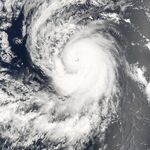The 2012 Great Salt Lake Hurricane Season was the first year in the satellite era to have tropical cyclones form in the Great Salt Lake.
Season Summary[]

The 2012 season was put together by short-lived, yet intense tropical cyclones. Five tropical depressions formed, with all becoming named storms. Four turned into hurricanes, and three became major hurricanes. An ACE of 35 was generated throughout the year.
Storms[]
Hurricane Anita[]
| Category 4 tropical cyclone (SSHWS) | |
| Duration | August 4 – August 8 |
|---|---|
| Peak intensity | 230 km/h (145 mph) (1-min) |
The disturbance that became Hurricane Anita started as a small, tiny cloud. The cloud absorbed lots of water over the Great Salt Lake, before finally becoming a group of thunderstorms meeting the requirement for a tropical cyclone. As such, it was classified as Tropical Depression One, becoming the first tropical cyclone in Great Salt Lake history. The depression rapidly intensified, becoming a tropical storm 12 hours later. It was named Anita by the weather centers of Salt Lake City. Anita continued to pick up warm waters, and in the span of 24 hours, explosively intensified from a moderate tropical storm to a powerful Category 3 hurricane. The hurricane continued to strengthen to a peak intensity of 145 mph and 944 mb on November 7. Anita then explosively weakened to a Category 1 hurricane six hours later, before finally dissipating.
No land areas were affected by Hurricane Anita.
Hurricane Babe[]
| Category 4 tropical cyclone (SSHWS) | |
| Duration | August 21 – August 24 |
|---|---|
| Peak intensity | 215 km/h (130 mph) (1-min) |
A trough of low pressure entered the Great Salt Lake in late August 2012. Several areas of convection formed from one area, and was classified as a tropical disturbance. The disturbance took an erractic track until August 21, where features similar to those found in a tropical depression were observed. However, winds of 51 mph were recorded near the heart of the cyclone. As such, the area was upgraded to a tropical storm, named Babe. Babe continued to increase in stregth and size until it was over 100 miles wide, covering almost all of the Great Salt Lake. It became a Category 1 hurricane later that day. As a hurricane, Babe mimicked the story of Hurricane Anita by explosively intensifing (EI) to a Category 4 within 18 hours, reaching a peak strength of 130 mph and 935 mb. Similar to Anita, Babe explosively weakened to a strong tropical storm on August 23, then became extratropical. The extratropical remains remained easily tracked as it crossed the coast, and it could be clearly identified as it moved southwest via the naked eye to a point north of San Francisco.


